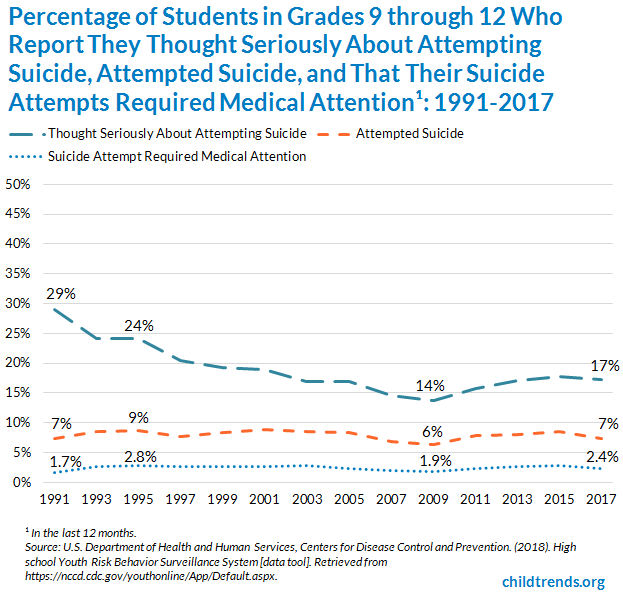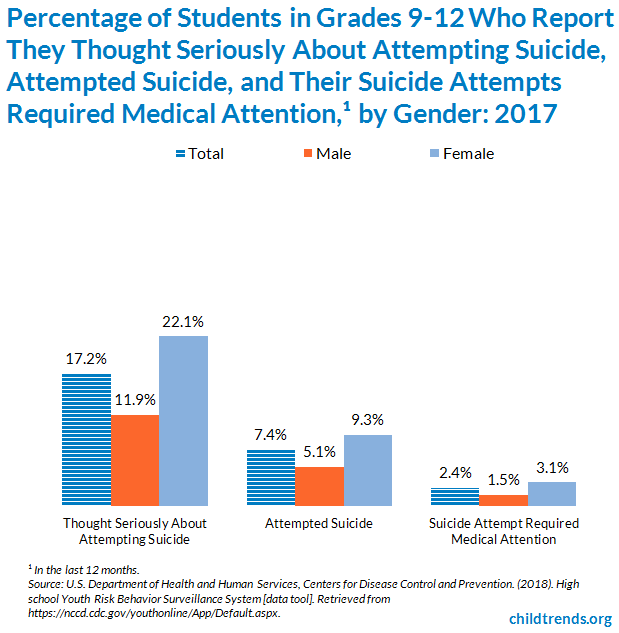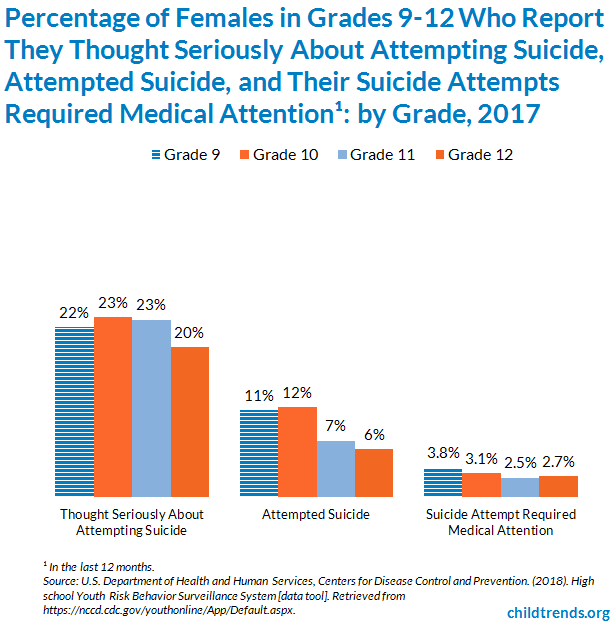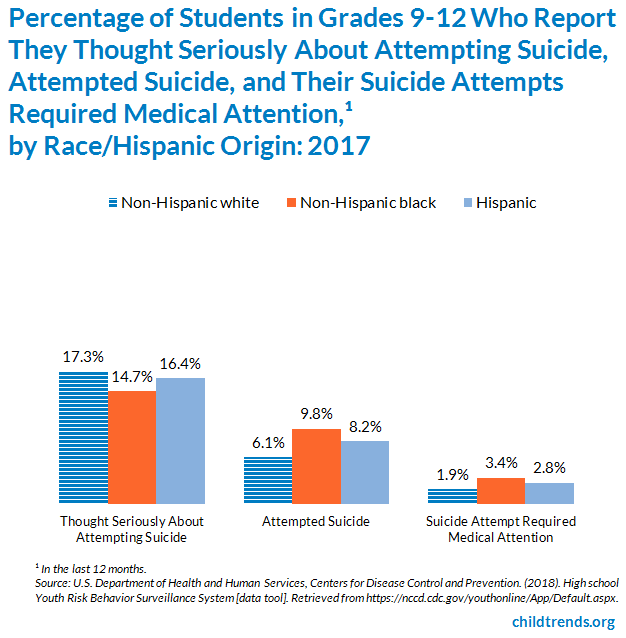The Child Trends databank of indicators related to child and youth well-being is no longer being updated so that we can focus on data tools and products core to the work of policymakers and other stakeholders, such as:
- State-level Data for Understanding Child Poverty
- State Level Data for Understanding Child Welfare in the United States,
- Black students and students with disabilities remain more likely to receive out-of-school suspensions, despite overall declines,
- Twitter Analysis Can Help Practitioners, Policymakers, and Researchers better understand topics relevant to American Indian/Alaska Native youth, and
- Mapping the Link between Life Expectancy and Educational Opportunity,
Trends in teen suicide
The percentage of high school students who reported that they had thought seriously about committing suicide in the last year declined from 29 percent in 1991 to a low of 14 percent in 2009. However, prevalence has increased since, reaching 17 percent in 2017. The proportion of students who reported having attempted suicide remained relatively constant in the 1990s and early 2000s (from 7 to 9 percent) but declined from 8 percent in 2005 to 6 percent in 2009. This trend reversed in 2011, with the proportion increasing to 8 percent that year and 9 percent in 2015, before dropping to 7 percent in 2017. A much smaller proportion, 2 to 3 percent of high school students, reported requiring medical attention as a result of a suicide attempt, and this proportion remained constant from 1991 to 2009. However, the proportion increased from 1.9 percent in 2009 to 2.8 percent in 2015. In 2017, the percent was 2.4 (Appendices 1, 2, and 3).

Differences by race and Hispanic origin*
In 2017, there were no clear disparities associated with these categories among females: 22 percent of non-Hispanic white, non-Hispanic black, and Hispanic teen girls reported seriously thinking about attempting suicide, while from 2 to 4 percent in all three groups reported their suicide attempt required medical attention. Among those who reported attempting suicide, the rate for non-Hispanic black teenage girls was somewhat higher, at 13 percent, compared to 11 and 7 percent of their Hispanic and non-Hispanic white peers, respectively. Among males, non-Hispanic black teens were less likely than their Hispanic and non-Hispanic white peers to report seriously considering suicide, at 7, 11, and 13 percent, respectively; however, they were more likely to report attempting suicide, at 7, 6, and 5 percent, respectively, in 2017 (Appendices 1, 2, and 3).
* Hispanics may be any race. Estimates for whites and blacks in this report do not include Hispanics.
Differences by gender

Females are about twice as likely as males to report seriously considering suicide (22 and 12 percent, respectively, in 2017), attempting suicide (9 and 5 percent, respectively), and requiring medical attention (3.1 and 1.5 percent, respectively). However, males are far more likely to succeed in committing suicide.*
*Child Trends. (2015). Teen homicide, suicide, and firearm deaths. Bethesda, MD. Retrieved from https://www.childtrends.org/?indicators=teen-homicide-suicide-and-firearm-deaths.
Differences by grade

In 2017, ninth-grade girls were almost twice as likely as their twelfth-grade counterparts to attempt suicide (11 versus 6 percent). There were no notable grade-level differences among females reporting seriously considering suicide (20 to 23 percent, by grade), or reporting their suicide attempt required medical attention (2.5 to 3.8 percent). Among males in 2017, twelfth graders were more likely than ninth graders to report seriously considering suicide, at 15 and 10 percent, respectively (Appendices 1, 2, and 3).
State and local estimates
2017 estimates for suicidal thoughts, attempts, and associated medical attention among high school students (Grades 9-12) are available for select states and cities from the Youth Risk Behavior Survey (YRBS) at https://www.cdc.gov/healthyyouth/
data/yrbs/pdf/2017/ss6708.pdf. (Tables 45 and 49)
Data & appendices
Data source
U.S. Department of Health and Human Services, Centers for Disease Control and Prevention. (2018). High School Youth Risk Behavior Surveillance System [data tool]. Retrieved from https://nccd.cdc.gov/youthonline
/App/Default.aspx.
Raw data source
Youth Risk Behavior Survey
http://www.cdc.gov/nccdphp
/dash/yrbs/index.htm
Appendices
Background
Definition
Students were asked the following questions:
- “During the past 12 months, did you ever seriously consider attempting suicide?”
- “During the past 12 months, how many times did you actually attempt suicide?”
- “If you attempted suicide during the past 12 months, did any attempt result in an injury, poisoning, or overdose that had to be treated by a doctor or nurse?”
Students from Oregon, Washington, and Minnesota were not included in the survey in any year. Students from California were included in the survey only in 2015. Additionally, students from, Indiana and Pennsylvania were not included in the 2013 survey, and students from Utah, Kansas, Texas, New Jersey, Iowa, Wisconsin, Louisiana, Ohio and Georgia were not included in the 2015 survey. Students from Colorado, and Iowa were not included in the 2013 or 2015 surveys. Students from Alabama, Georgia, Indiana, Minnesota, Mississippi, Ohio, South Dakota, Washington, and Wyoming are not included in 2017 estimates.
Suggested Citation:
Child Trends Databank. (2019). Suicidal teens. Available at: https://www.childtrends.org/
publications/teen-suicide-
databank-indicator
© Copyright 2025 ChildTrendsPrivacy Statement
Newsletter SignupLinkedInYouTubeBlueskyInstagram